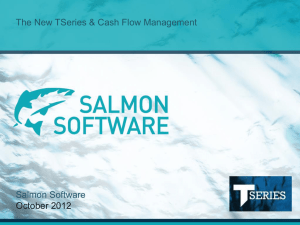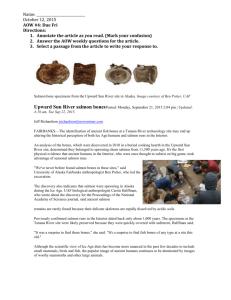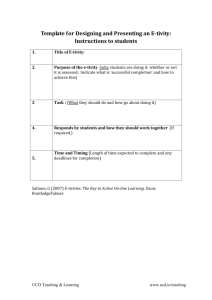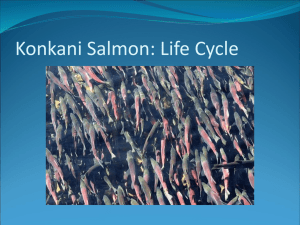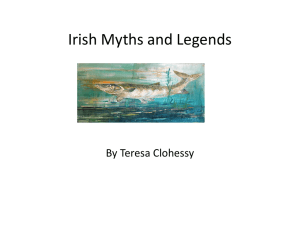Critical Issues in on-line learning
advertisement
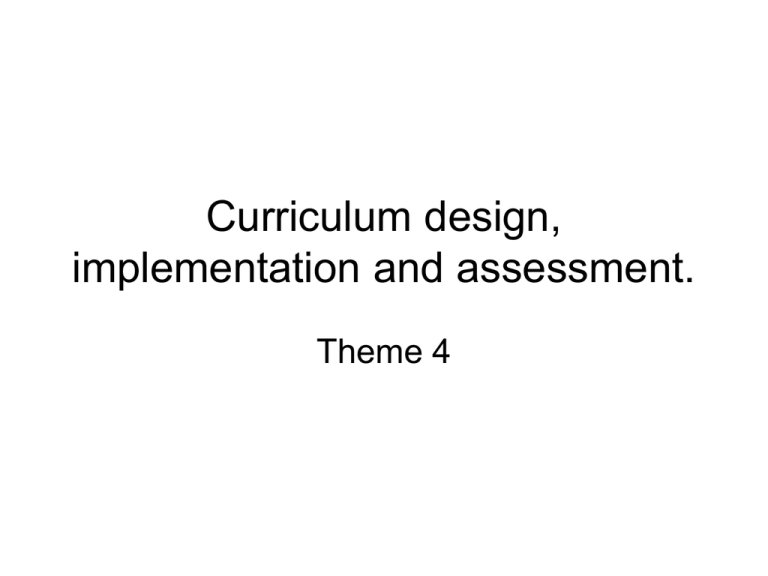
Curriculum design, implementation and assessment. Theme 4 Taking risks Constructive alignment (complicated phrase for a simple idea) • Have you come across the term? • http://www.engsc.ac.uk/er/theory/constructive_ali gnment.asp • John Biggs (1999): Teaching for Quality Learning at University, (SRHE and Open University Press, Buckingham • John Biggs (2003): Aligning Teaching and Assessment to Curriculum Objectives, (Imaginative Curriculum Project, LTSN Generic Centre activity • What do you think might be some of the pros and cons of constructive alignment? Benefits? • • • • • • • Clarity ( is learning always about this?) Objectives clear to students appropriateness of assessment learning drives assessment encourages deep learning good for corporate learning? good for independent learning Issues with constructive alignment • Not easy • http://www.phil-race.com/downloads.html (Understanding) • mechanistic? • Repetitive? • Ongoing process to perfect and adapt • Need to be able to adapt modules easily – curriculum development implications eg ICT in Teaching and Learning • Kills creativity/ diversity in learning and teaching? • OFSTED - school inspectors --- after spending the last five years getting teachers to teach to objectives –what was their big critique in the last report -- ??? Have a go • Think of a module you teach/or would like to teach • aim? • Learning outcome? • LTA strategy? • http://www.leedsmet.ac.uk/the_news/change/documents/ Version32AssesmentTeachingLearningStrategy1.pdf • LTA methods? • Assessment criteria? • Student support ? Have you ever designed a module from scratch – what do you think is required to design quality modules? ? What is the reality? Constraints • • • • • • Uni regulations Faculty regulations Regulations of associations/ bodies/ societies Current departmental practice Admin issues Technology issues • Useful to externally examine/validate courses lots of ideas Implementation • • • • • theories experience realities constraints Variety of appropriate techniques and styles – add interactivity to facility deep learning Assessment • Think of time – anytime -- from childhood onwards when someone made an assessment of you which had • A. a positive impact • B. a negative impact Assessment and feedback (pros and cons) • • • • Summative Formative – assessment for learning Ipsative Diagnostic • Peer assessment • Self assessment Feedback Be sensitive Can be hard to take Will – early problems Marco – consequences of poor assessment Early formative assessment in yr 1 Accuracy at degree level • Thanks for mark of 81 Kill your prejudices - assessment at one level is not a predictor of future learning • Boyle, R D; Carter, J E; Clark, M A C. What makes them succeed? Entry, progression and graduation in Computer Science. Journal of Further and Higher Education, vol. 26, pp. 3-18. 2002. Think of attainment levels not fixed ability • Think of Life-long learning not early labels • Move to individual assessment personalised learning Evaluation – who/how? • Compare/ contrast Old /new student evaluations Staff evaluations/ peer observation Issues? When you do it ? How you do it? Get feedback when you can – but use it constructively don’t take it to heart You feel as good as your last lesson/ evaluation Issues in on-line learning Bridget Cooper What sort of things do we mean when we talk about remote, elearning? • What potential advantages might there be for students when using remote or on-line E-learning to students? • What are the possible disadvantages to students? • What might the differences be in remote learning compared to face to face learning? • What are the advantages to tutors? • What are the problems for tutors? Ignore the hype!!! Evaluate Gilly Salmon • http://www.atimod.com/index.shtml • http://www.atimod.com/research/publicatio ns.shtml Many similarities to any teaching and learning – -many complex factors interrelating Classroom ambience and quality of learning dependant on degree of profound empathy available for individuals Teacher quality Time Curricular Flexibility teacher /pupil ratio Quality/ amount/frequency of positive interaction leading to profound empathy Nature and groupings of pupils in class Quality of management Facilitative quality of environment 7 Similarities • • • • • • • Quality of interaction is central Needs to be positive - frequent Emotions fairly central to experience All groups different All courses different All tutors interact differently with students Careful forethought about structure /materials helps process – doesn’t predict it however • Enthusiasm crucial • Experience naturally helpful Learning theory still valid • However systems not necessarily designed to support process of learning – more for programmers edification • Designers frequently forget …..emotion and the part it plays in learning • Remember 93% non--verbal Differences • Medium is different – new strange: threatening • You are at the mercy of the software and technicians – although you always were – ever arrived to find the door locked –the gate impenetrable? - that cold rejected feeling?? Its bloody cold out ‘ere mate It blooming is too! He’s not wrong.. Fear of the new? • Doors/rooms are familiar – VLEs are not – • if you can’t get in you can’t learn – you need a learning space • some VLES try to make the connection between face to face and virtual learning • Differences between VLES can be superficial – or significant • The interface is crucial - ease of use – vital = access – no barriers to learning for learners or tutors • Needs to be designed for easy learning • Does it favour interaction or transmission? • Does it favour machines or humans? • • • • webCT first class Boddington OU interactive Interactivity • http://www.open2.net/learning.html Gilly’s five stage model • Stage 1 -- Individual access and the ability of participants to use CMC are essential prerequisites for conference participation • Stage two - involves individual participants establishing their online identities and then finding others with whom to interact. • Stage three - participants give information relevant to the course to each other. Up to and including stage three, a form of co-operation occurs, i.e. support for each person’s goals. • Stage four - course-related group discussions occur and the interaction becomes more collaborative. The communication depends on the establishment of common understandings. • Stage five - participants look for more benefits from the system to help them achieve personal goals, explore how to integrate CMC into other forms of learning and reflect on the learning processes. e-tivities: easy cheap active online learning e-tivities address either one stage of the 5 stage model and/or movement between them DVPT. KNOWLEDGE CONSTRUCT INF. EXCHANGE SOCIALISATION ACCESS & MOTIVATION • Many institutions/ courses – only using VLES as a repository……. Solutions • • • • • • • • Blended learning = more variety best of all worlds Reclaim non-verbal in face to face Virtual learning works best when coupled with face to face – communication increases – range of interaction improved New tutors start small and build – administrative technical support very variable – make VLE part of course – talk in detail to someone who has a successful course running in your area Case studies very successful means for dialogue(example) Try sharing a discussion yourselves – log in to webct – go to the PGCHE module – then to discussions – then theme four and read my message - add yours. Have put other articles on webct in theme four and will send this powerpoint • Recent Books and Journal articles by Gilly Salmon • Competencies for online teaching. Education Training & Development 49 (1) :pp. 65-72 Goodyear, P., G. Salmon and C. Steeples (2001) Academic Integrity in Electronic Universities of the New Millennium: a Practitioner's Perspective Higher Education in Europe XXIV (2) :pp. 259-264 Gray, C. and G. Salmon (1999) Developing Learning Though Effective Online Moderation. Active Learning pp. 3-8 Salmon, G. (1998) Student Induction & Study Preparation Online. Proceedings of Networks of Skills and Competence: Telematics in Education Joensuu, Finland, September Salmon, G. (1998) Computer Mediated Conferencing in Large Scale Management Education Open Learning (June) :pp. 45-54 Salmon, G. (1999) Developing Managers Through Online Networking. The Current State of Business Disciplines S. B. Sahiya (Ed). Rohtak, India, Spellbound Publications Salmon, G. (1999) Computer Mediated Conferencing for Management Learning at the Open University. Management Learning 31 (4) :pp. 491-502 Salmon, G. (2000) Driving Through! Online learning for industrial supply chains The Turkish Online Journal of Distance Education 1 (2/ July) :pp Salmon, G. (2000) E-moderating: the key to teaching and learning online London, Kogan Page Salmon, G. (2000) • • • • • • • • • • • • • • • • • • The Business Cafe Project: viewing to browsing? British Journal of Educational Technology 32 (1) :pp. 91-104 Salmon, G. (2001) E-moderating: turning the e-learning fantasy into reality Malaysian Journal of Educational Technology 1 (1) :pp. 19-27 Salmon, G. (2001) Approaches to researching teaching and learning online. Networked Learning:perspectives and issues C. Steeples and C. Jones (Ed). London, Springer-Verlag Salmon, G. (2002) E-tivities: the key to active online learning London, Kogan Page Salmon, G. (2002) Mirror, Mirror, on my screen... Exploring online reflections The British Journal of Educational Technology 33 (4) 383-396 Salmon, G. (2002) Training Virtual Management Teachers European Journal of Open & Distant Learning 1 (1) Salmon, G. and K. Giles (1997) Creating and implementing successful on-line learning environments: a practitioner perspective Proceedings of European Distance Education Network (EDEN), Bologna, Italy, EDEN Salmon, G. and K. Giles (1998) Training for Online Working. Managing Telework K. Daniel, D. Lamond and P. Standen (Ed). London, Thompson Salmon, G., K. Giles and J. Allan (2000) Creating and Implementing Successful Online Environments: A Practitioner Perspective European Open and Distance Learning Journal (February) Salmon, G. and K. E. Giles (1999) See Bob Rotherham’s slides on web-site for more ideas on on-line learning critique • http://www.phil-race.com/downloads.html • The future of online learning - and 'false dawns and failed prophets' • Cooper (2007) -see docs for theme three – Journal of Interactive and Smart technology • Mayes(2000) Pedagogy, Lifelong Learning and ICT Tasks for formative assessment • 1, Prepare a five slide presentation in pairs which raises one issue in your teaching for us to discuss on line and relate it to any theory (be imaginative –use visuals/links etc) will put on line and discuss) (peer assessment) • 2. Write a (concise) five hundred word reflective statement which considers how you can relate some of the theories and discussions we have considered to aspects of your teaching. • Will give you written feedback on this – both can go in your portfolio and can be looked back on in a years time… in your synoptic statement



